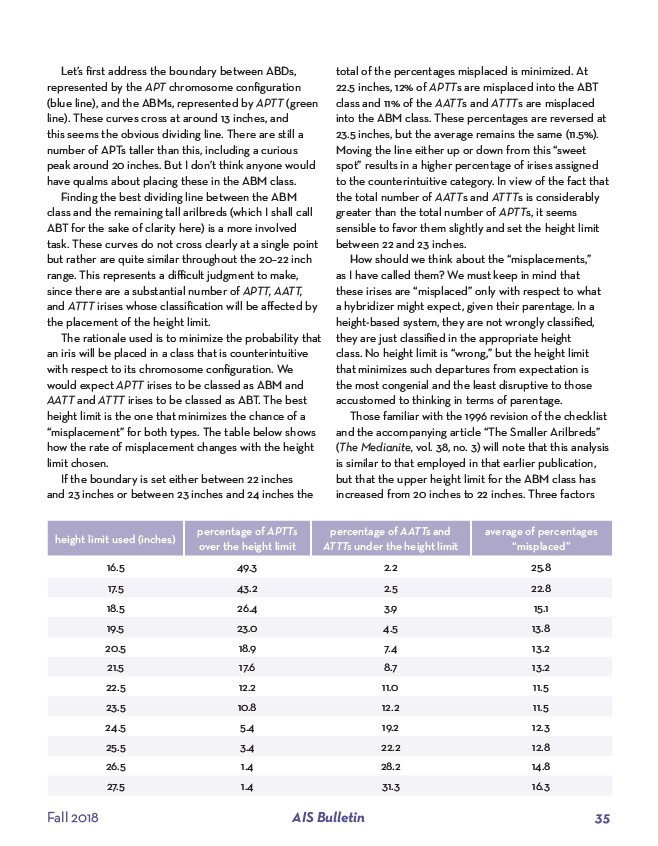
Let’s first address the boundary between ABDs,
represented by the APT chromosome configuration
(blue line), and the ABMs, represented by APTT (green
line). These curves cross at around 13 inches, and
this seems the obvious dividing line. There are still a
number of APTs taller than this, including a curious
peak around 20 inches. But I don’t think anyone would
have qualms about placing these in the ABM class.
Finding the best dividing line between the ABM
class and the remaining tall arilbreds (which I shall call
ABT for the sake of clarity here) is a more involved
task. These curves do not cross clearly at a single point
but rather are quite similar throughout the 20–22 inch
range. This represents a difficult judgment to make,
since there are a substantial number of APTT, AATT,
and ATTT irises whose classification will be affected by
the placement of the height limit.
The rationale used is to minimize the probability that
an iris will be placed in a class that is counterintuitive
with respect to its chromosome configuration. We
would expect APTT irises to be classed as ABM and
AATT and ATTT irises to be classed as ABT. The best
height limit is the one that minimizes the chance of a
“misplacement” for both types. The table below shows
how the rate of misplacement changes with the height
limit chosen.
If the boundary is set either between 22 inches
and 23 inches or between 23 inches and 24 inches the
total of the percentages misplaced is minimized. At
22.5 inches, 12% of APTTs are misplaced into the ABT
class and 11% of the AATTs and ATTTs are misplaced
into the ABM class. These percentages are reversed at
23.5 inches, but the average remains the same (11.5%).
Moving the line either up or down from this “sweet
spot” results in a higher percentage of irises assigned
to the counterintuitive category. In view of the fact that
the total number of AATTs and ATTTs is considerably
greater than the total number of APTTs, it seems
sensible to favor them slightly and set the height limit
between 22 and 23 inches.
How should we think about the “misplacements,”
as I have called them? We must keep in mind that
these irises are “misplaced” only with respect to what
a hybridizer might expect, given their parentage. In a
height-based system, they are not wrongly classified,
they are just classified in the appropriate height
class. No height limit is “wrong,” but the height limit
that minimizes such departures from expectation is
the most congenial and the least disruptive to those
accustomed to thinking in terms of parentage.
Those familiar with the 1996 revision of the checklist
and the accompanying article “The Smaller Arilbreds”
(The Medianite, vol. 38, no. 3) will note that this analysis
is similar to that employed in that earlier publication,
but that the upper height limit for the ABM class has
increased from 20 inches to 22 inches. Three factors
height limit used (inches)
percentage of APTTs
over the height limit
percentage of AATTs and
ATTTs under the height limit
average of percentages
“misplaced”
16.5 49.3 2.2 25.8
17.5 43.2 2.5 22.8
18.5 26.4 3.9 15.1
19.5 23.0 4.5 13.8
20.5 18.9 7.4 13.2
21.5 17.6 8.7 13.2
22.5 12.2 11.0 11.5
23.5 10.8 12.2 11.5
24.5 5.4 19.2 12.3
25.5 3.4 22.2 12.8
26.5 1.4 28.2 14.8
27.5 1.4 31.3 16.3
Fall 2018 AIS Bulletin 35